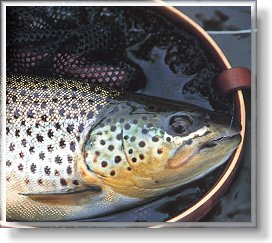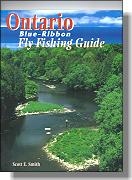The Blue-Ribbon Grand - Part 2
By Scott E. Smith
Any of my fishing compatriots can attest to the fact that I have a propensity
for falling in, and inadvertently swimming in, many of the rivers I fish. I could
attribute this to a couple of old sports injuries, but mainly it's because I'm
usually looking at places other than where my feet are being placed.

The river is ideal for walk-and-wade angling, with lots of access points, trails and
crossing points. In addition, the setting is spectacular: lush green ferns and
foliage interepersed with yellow and purple blossoms along the banks; Canada
geese, deer and mink are regular inhabitants of the same streamside frondescence.
All of this gives you the sense that you are in a much more remote place than
you really are. The river is nicely sheltered from roads and building by forested
parklands of cedar and pine. The exception to this is the class old stone
grist-mills along the river. They add character, but also provide for a nice
deep pool on the river at their base.
Surprisingly, the river is not crawling with anglers as one might expect.
I've seen some interesting spectacles of shoulder-to-shoulder fishing on
some other stretches of honey-hole water. But at least when I fished the
Grand River I did not get that subtle but persistent feeling that I'd better pee in
my waders than give up my spot when I moved, like I've sensed in other places.
I recall fishing alone one morning on the Article Pool (Trestle area in Section 2)
with little competition. I arrived at the river at a leisurely 8:00 a.m., and fished
alone until 10:00 a.m. when the first anglers came on the scene and courteously
circumvented my "place" as they moved downstream. During this time I landed
two chunky eighteen-inch browns and a scrappy little ten-incher. Not bad
considereing I was still within a two-hour drive of the thriving metropolises of
Toronto, Hamilton and Mississauga.
I've spent most of my fishing time on the river with John Valk and Barney
Jones of Grindstone Angling Specialties. Both men guide on the river and
know it very well. John fishes the whole 13 kilometers of the special regulations
water and follows the hatch and trends from one stretch of another to any good
student of a fly-fishing river. John likes the gorge section of the river (between
Section 2 and 3) for its resemblance to the Umpqua River Valley, with its sheer
cliffs and brisk flows. Because of these same factors - sheer cliffs and brisk
flows - this section of the river is not the best place for a beginner. In fact,
John will not take clients into the gorge unless conditions are absolutely
conductive to safe passage. Once you're in the gorge there is no way out,
and purchase along the bedrock bottom of the river is precarious at best.
This stretch is also targeted by canoeists, kayakers and sunworshippers,
which can be an added pain - unless they're shooting a layout for the
Sports Illustrated Swimsuit Edition (dream on).
 I found the brisker sections of the river more to my liking. I suppose they
are reminiscent of the pocket-water streams along Superior's shore that I call
home. On the Grand, the faster gradients runs fished well with nymphs, and
even better with dries during a hatch. The flatter, deeper, more languid
sections of the river I found difficult to fish because of, well, difficult fish.
The browns in these areas tended to be big "educated" fish that refused even
the best presentations. But this is to expected on any popular trout stream. Trout
in flats and slow pools are difficult anywhere you go. John and Barney, however,
did not have the same difficulties in hooking fish in these areas; adding that
fishing some of these pools was a science in itself. Regardless of your particular
tastes for water types, the Grand has it all in a nicely manageable package.
I found the brisker sections of the river more to my liking. I suppose they
are reminiscent of the pocket-water streams along Superior's shore that I call
home. On the Grand, the faster gradients runs fished well with nymphs, and
even better with dries during a hatch. The flatter, deeper, more languid
sections of the river I found difficult to fish because of, well, difficult fish.
The browns in these areas tended to be big "educated" fish that refused even
the best presentations. But this is to expected on any popular trout stream. Trout
in flats and slow pools are difficult anywhere you go. John and Barney, however,
did not have the same difficulties in hooking fish in these areas; adding that
fishing some of these pools was a science in itself. Regardless of your particular
tastes for water types, the Grand has it all in a nicely manageable package.
Visibility in the Grand is generally good. It varies from very clear with a slight
greenish tinge, to brownish and turbid when it is running high due to a thunderstorm;
after which it clears relatively quickly. The visibility also diminishes during the
height of the algae bloom in August. This incidentally, is also the lowest percentage
time for hooking larger browns in the river. When I fished the Grand in June, the
visibility was clear enough that I could spot large browns flashing on the bottom
while nymphing in runs that were about three feet deep. The slight colouration
of the water meant that I could still move about on the river without spooking the
feeders. This meant that the conditions were just about perfect; clairity changes
in either direction would make the fishing much more difficult.
I find this fishing situation quite intriguing: that is to arrive at a stretch of water
that at first seems devoid of trout, but some careful examination below the
surface, the very reason you're there shows itself from time to time, just enough
to keep you focused.

Indeed as I fished the Grand from pool to pool, run to run, day after day, I
found myself growing more interested in fishing it as time went on. I wish it
was closer to home for me; then again, if it was closer I might find myself
spending too much time there. If that is possible.
The brown trout of the Grand River are thick, healthy, strong fish. An
eighteen-inch fish is not a big deal, as many fish in the river are in excess of
twenty inches. Once the trout reach that size, they seem to grow disproportionately
more in girth than length, which is due to the high amounts of available good in
the river. ~ Scott E. Smith
Next time more fishing the Grand!
From: Ontario Blue-Ribbon Fly Fishing Guide.We thank
Frank Amato Publications, Inc. for re-print permission!
|



